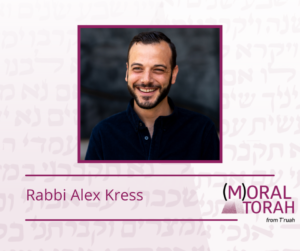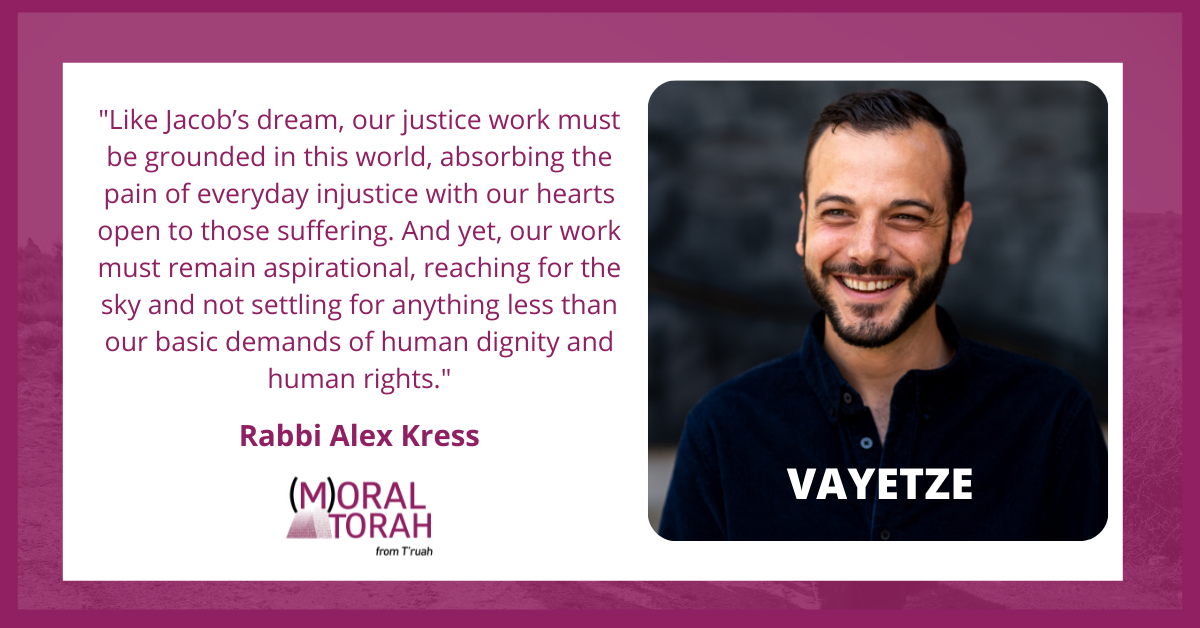A D’var Torah for Parshat Vayetze by Rabbi Alex Kress
Sitting in a jail cell in 1964, Dr. Martin Luther King Jr. sent a telegram to the annual conference of Reform rabbis. Dr. King and the Southern Christian Leadership Conference were planning actions to push the Civil Rights Bill of 1964 over the finish line. They thought rabbis might help them garner national attention for a public protest and mass arrest in St. Augustine, Florida, the home of the oldest slave records on the continent and a deeply embedded racial divide. He invited them there to bear “prophetic witness against the social evils of our time” and join in the action.
My teacher Rabbi Richard Levy z”l was one of the few rabbis who answered Dr. King’s call that summer. Just a few weeks after his ordination, he arrived in St. Augustine with 16 other rabbis — of the 500 present at the conference — to confront the world as it was. That night, they joined over 300 local protesters in their night march through the city as white citizens lined the sidewalk armed with baseball bats, broken bottles, and bricks. As they marched through a heavy silence past the haunting site of St. Augustine’s Slave Market, Rabbi Levy clutched the hand of a little girl with whom he had been paired. Though he knew he was meant to be her protection, he recalled his fear and the sense that she was the one holding him steady.
Sign up to receive (M)oral Torah in your inbox each week.
The following morning, Thursday, June 18, 1964, the rabbis gathered at a local church for morning prayers, using the bibles in the pews to recite the weekly Torah portion. Rabbi Levy found himself near Dr. King, who thumbed through his well-worn bible searching for words to share with the rabbis. He landed on Psalm 27: “The Lord is my light and my help; whom should I fear?”
Illustrated in these contrasting scenes is the duality of the world-as-it-is and the world-as-it-could-be. We see the world-as-it-is with Rabbi Levy marching hand in hand with a little girl through mobs of anger and violence for daring to advocate for equality. Then, not twelve hours later, we hear Dr. King delivering a scriptural vision of the world-as-it-could-be to fellow justice seekers, from the safety of sacred space and the spiritual communion spanning diverse faiths and backgrounds. Shortly after, they dispersed from the church to begin their protests around St. Augustine and confront the world-as-it-was. This concept of the dual worlds is a powerful justice paradigm, and we find a similar idea in Parshat Vayetze this week.
Jacob leaves his home in Be’er Sheva and heads toward Haran. He finds a place to rest for the evening and falls asleep resting his head on a stone when he has a dream: “a ladder set on the ground and its top reached to the sky, and angels of God were going up and down on it” (Genesis 28:12). Jacob, the soon-to-be namesake of the people Israel, has a dream of something at once firmly rooted in this world and yet reaching toward the sky; something knowable and yet stretching toward another possibility. This description of Jacob’s ladder can serve as a guideline for justice work, both personally and collectively. Like Jacob’s dream, our justice work must be grounded in this world, absorbing the pain of everyday injustice with our hearts open to those suffering. And yet, our work must remain aspirational, reaching for the sky and not settling for anything less than our basic demands of human dignity and human rights.
Yet building the world-as-it-should-be is a recurrent challenge because paying lip service to ideals is easier than following through with the action that brings them to life. Dr. King diagnosed a similar problem in a 1958 speech to the American Jewish Congress: “Today we are finding, too often, a quasi-Liberalism which is committed to the principle of looking sympathetically at all sides. It is a Liberalism so objectively analytical that it fails to become subjectively committed. It is a Liberalism which has developed a high blood pressure of words and an anemia of deeds.” Dr. King’s words may very well be an indictment of today, too. Though we lift up a divine blueprint of our dreams of a world-as-it-should-be, our actions often leave our world unchanged, as-it-is.
Find more commentaries on Vayetze.
When Jacob awoke from his dream, he said, “God is in this place, and I did not know.” Like Jacob, it might be easy to miss God in our world. Gazing out at a world in chaos, we see injustice everywhere. Yet we must remember God is realized in our deeds. Our responsibility of Tikkun Olam, repairing the world, is only fulfilled through tangible action, not just dreaming of what could be, and we must take great care not to compromise that responsibility in the face of convenience, temptation, and personal gain. We are tasked with repairing the entire world, not simply the bubble where we walk our dogs, raise our kids, and feel safe. We are charged with creating a better world for every population and people, as we are all made in the divine image.
 Rabbi Levy taught his students to see every individual with a divine glow, as if the letters of God’s name י-ה-ו-ה were hovering over their head. When we view ourselves this way too, we can recognize our ability to realize God’s presence through our actions and inch closer to the world-as-it-should-be.
Rabbi Levy taught his students to see every individual with a divine glow, as if the letters of God’s name י-ה-ו-ה were hovering over their head. When we view ourselves this way too, we can recognize our ability to realize God’s presence through our actions and inch closer to the world-as-it-should-be.
Rabbi Alex Kress serves Beth Shir Shalom in Santa Monica, CA. His rabbinate centers on pursuing justice, inclusion, and good synagogue coffee. He works to incorporate avant-garde ideas that revitalize spirituality and community. With projects like Hip Hop High Holidays, he attempts to bridge ancient wisdom with contemporary culture to make our tradition relevant and accessible.

